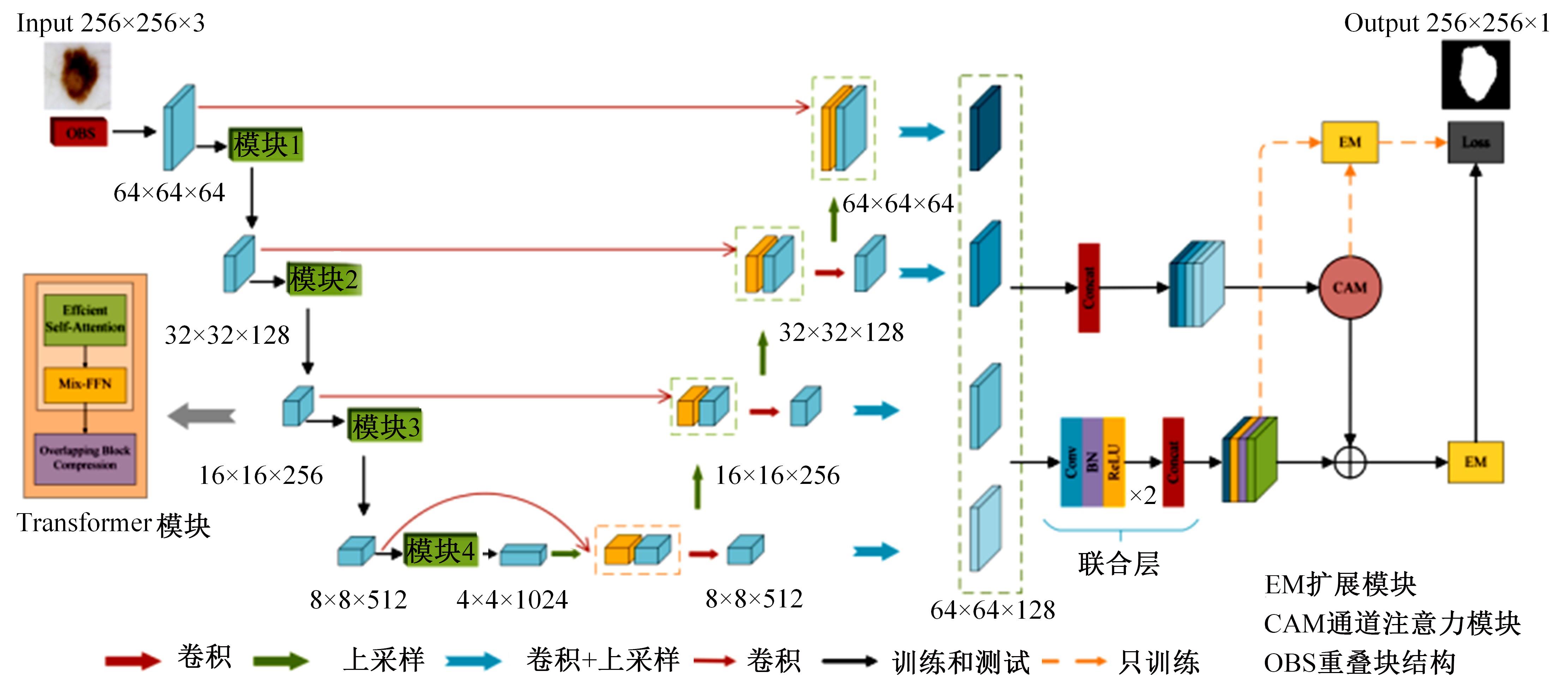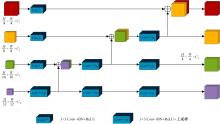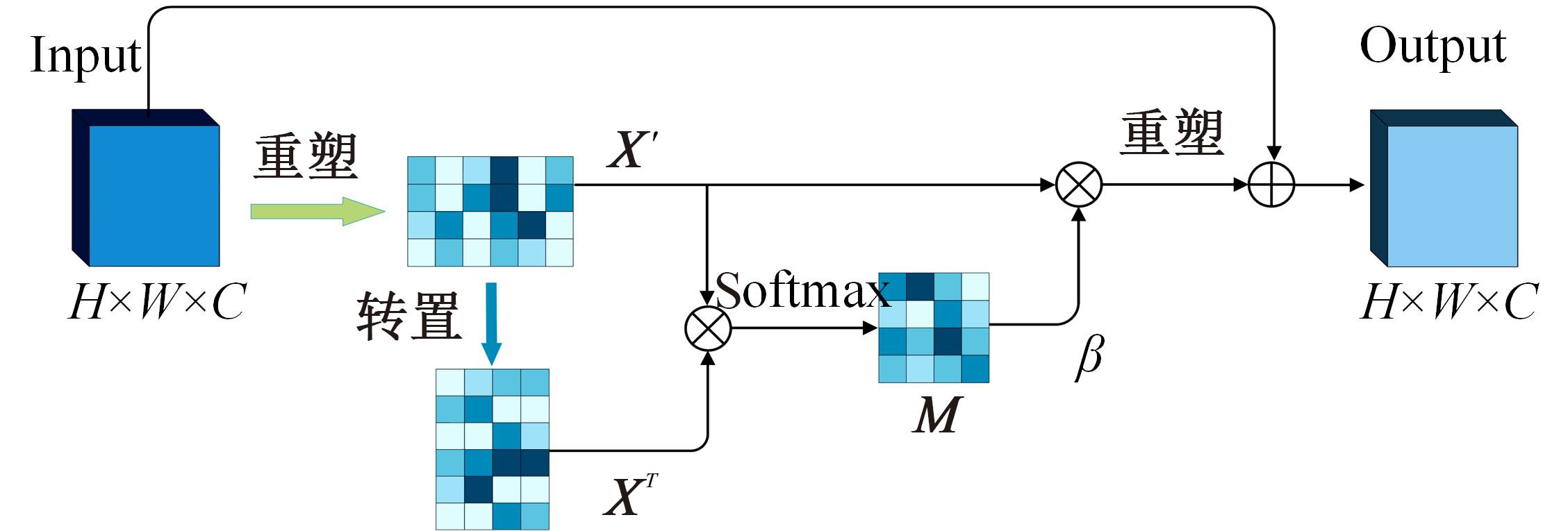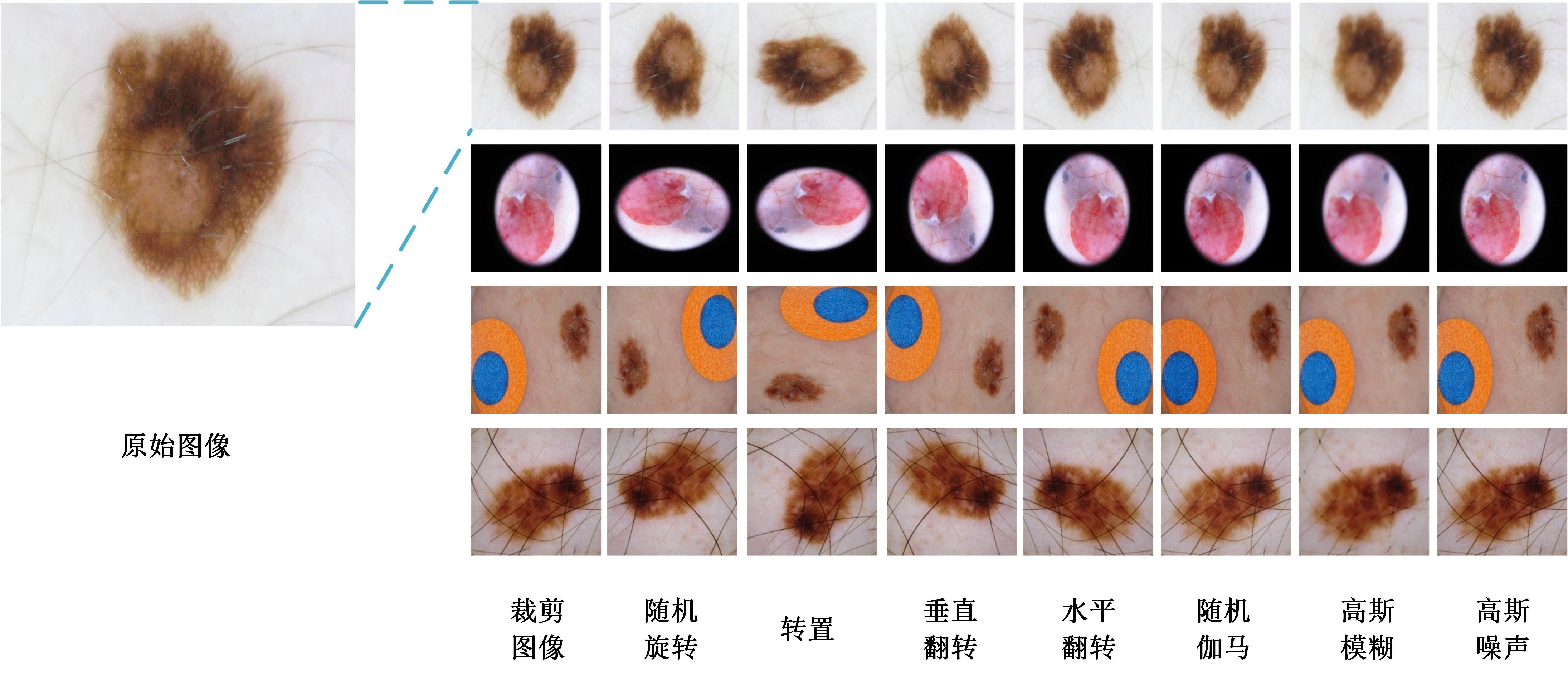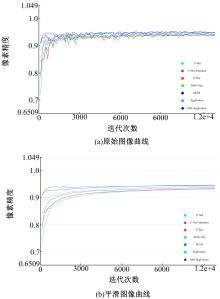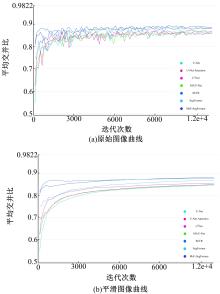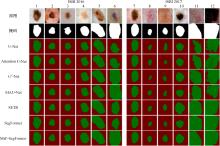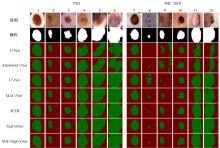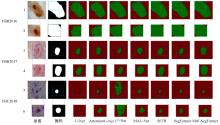Journal of Jilin University(Engineering and Technology Edition) ›› 2024, Vol. 54 ›› Issue (4): 1086-1098.doi: 10.13229/j.cnki.jdxbgxb.20220692
Fusion multi-scale Transformer skin lesion segmentation algorithm
Li-ming LIANG1( ),Long-song ZHOU1,Jiang YIN1,Xiao-qi SHENG2
),Long-song ZHOU1,Jiang YIN1,Xiao-qi SHENG2
- 1.School of Electrical Engineering and Automation,Jiangxi University of Science and Technology,Ganzhou 341000,China
2.School of Computer Science and Engineering,South China University of Technology,Guangzhou,510006,China
CLC Number:
- TP183
| 1 | Jin Q, Cui H, Sun C, et al. Cascade knowledge diffusion network for skin lesion diagnosis and segmentation[J]. Applied Soft Computing, 2021, 99:No. 106881. |
| 2 | Sarker M M K, Rashwan H A, Akram F, et al. SLSNet: skin lesion segmentation using a lightweight generative adversarial network[J]. Expert Systems with Applications, 2021, 183: No.115433. |
| 3 | 欧阳继红, 郭泽琪, 刘思光. 糖尿病视网膜病变分期双分支混合注意力决策网络[J]. 吉林大学学报: 工学版, 2022, 52(3): 648-656. |
| Ouyang Ji-hong, Guo Ze-qi, Liu Si-guang. Dual⁃branch hybrid attention decision net for diabetic retinopathy classification[J]. Journal of Jilin University(Engineering and Technology Edition), 2022, 52(3): 648-656. | |
| 4 | 王雪, 李占山, 吕颖达. 基于多尺度感知和语义适配的医学图像分割算法[J]. 吉林大学学报: 工学版, 2022, 52(3): 640-647. |
| Wang Xue, Li Zhan-shan, Ying-da Lyu. Medical image segmentation based on multi⁃scale context⁃aware and semantic adaptor[J]. Journal of Jilin University(Engineering and Technology Edition), 2022, 52(3): 640-647. | |
| 5 | 王生生, 陈境宇, 卢奕南. 基于联邦学习和区块链的新冠肺炎胸部CT图像分割[J]. 吉林大学学报: 工学版, 2021, 51(6): 2164-2173. |
| Wang Sheng-sheng, Chen Jing-yu, Lu Yi-nan. COVID⁃19 chest CT image segmentation based on federated learning and blockchain[J]. Journal of Jilin University(Engineering and Technology Edition), 2021, 51(6): 2164-2173. | |
| 6 | 张恒良, 李锵, 关欣. 一种改进的三维双路径脑肿瘤图像分割网络[J]. 光学学报, 2021, 41(3): 54-61. |
| Zhang Heng-liang, Li Qiang, Guan Xin. An improved three-dimensional dual-path brain tumor image segmentation network[J]. Acta Optica Sinica, 2021, 41(3): 54-61. | |
| 7 | Shelhamer E, Long J, Darrell T. Fully convolutional networks for semantic segmentation[J]. IEEE Transactions on Pattern Analysis and Machine Intelligence, 2016, 39(4): 640-651. |
| 8 | Ronneberger O, Fischer P, Brox T. U-net: convolutional networks for biomedical image segmentation[C]∥International Conference on Medical Image Computing and Computer Assisted Intervention, Berlin,Germany, 2015: 234-241. |
| 9 | Sarker M, Kamal M, Rashwan H A, et al. SLSDeep: skin lesion segmentation based on dilated residual and pyramid pooling networks[C]∥International Conference on Medical Image Computing and Computer-Assisted Intervention, Granada, Spain, 2018: 21-29. |
| 10 | Gu R, Wang L, Zhang L. DE-Net: a deep edge network with boundary information for automatic skin lesion segmentation[J]. Neurocomputing, 2022, 468: 71-84. |
| 11 | Dosovitskiy A, Beyer L, Kolesnikov A, et al. An image is worth 16×16 words: Transformers for image recognition at scale[J/OL]. [2020-09-23].. |
| 12 | Cao H, Wang Y, Chen J, et al. Swin-Unet: Unet-like pure Transformer for medical image segmentation[J/OL]. [2021-11-10]. . |
| 13 | Wang W, Xie E, Li X, et al. Pyramid vision Transformer: a Versatile backbone for dense prediction without convolutions[C]∥Proceedings of the IEEE/CVF International Conference on Computer Vision, Montreal, Canada, 2021: 568-578. |
| 14 | Xie E, Wang W, Yu Z, et al. SegFormer: simple and efficient design for semantic segmentation with transformers[J/OL]. [2021-09-16].. |
| 15 | Petit O, Thome N, Rambour C, et al. U-net Transformer: self and cross attention for medical image segmentation[C]∥International Workshop on Machine Learning in Medical Imaging, Nagoya, Japan, 2021: 267-276. |
| 16 | Islam M A, Jia S, Bruce N D B. How much position information do convolutional neural networks encode?[J/OL]. [2020-08-17]. . |
| 17 | Chu X, Tian Z, Zhang B, et al. Conditional positional encodings for vision transformers[J/OL]. [2021-07-26]. . |
| 18 | Fu J, Liu J, Tian H, et al. Dual attention network for scene segmentation[C]∥Proceedings of the IEEE/CVF Conference on Computer Vision and Pattern Recognition, Long Beach, USA, 2019: 3146-3154. |
| 19 | Gutman D, Codella N C F, Celebi E, et al. Skin lesion analysis toward melanoma detection: a challenge at the international symposium on biomedical imaging (ISBI) 2016, hosted by the international skin imaging collaboration (ISIC)[J/OL].[2016-08-24]. . |
| 20 | Codella N C F, Gutman D, Celebi M E, et al. Skin lesion analysis toward melanoma detection: a challenge at the 2017 international symposium on biomedical imaging (ISBI), hosted by the international skin imaging collaboration (isic)[C]∥IEEE 15th International Symposium on Biomedical Imaging(ISBI 2018), WashingtonDC, USA, 2018: 168-172. |
| 21 | Tschandl P, Rosendahl C, Kittler H. The HAM10000 dataset, a large collection of multi-source dermatoscopic images of common pigmented skin lesions[J]. Scientific Data, 2018, 5(1): 1-9. |
| 22 | Mendonça T, Ferreira P M, Marques J S, et al. PH 2-A dermoscopic image database for research and benchmarking[C]∥The 35th Annual International Conference of the IEEE Engineering in Medicine and Biology Society(EMBC), Osaka, Japan, 2013: 5437-5440. |
| 23 | Loshchilov I, Hutter F. Decoupled weight decay regularization[J/OL].[2017-06-24]. . |
| 24 | Oktay O, Schlemper J, Folgoc L L, et al. Attention U-net: learning where to look for the pancreas[J/OL]. [2018-10-22]. . |
| 25 | Qin X, Zhang Z, Huang C, et al. U2-Net: Going deeper with nested U-structure for salient object detection[J]. Pattern Recognition, 2020, 106: No.107404. |
| 26 | 梁礼明, 尹江, 彭仁杰, 等. 基于多尺度注意力的皮肤镜图像自动分割算法[J]. 科学技术与工程, 2021,21(34): 14644-14650. |
| Liang Li-ming, Yin Jiang, Peng Ren-jie, et al. Automatic segmentation algorithm of dermoscopy images based on multi-scale attention[J]. Science Technology and Engineering, 2021, 21(34): 14644-14650. | |
| 27 | Zheng S, Lu J, Zhao H, et al. Rethinking semantic segmentation from a sequence-to-sequence perspective with transformers[C]∥Proceedings of the IEEE/CVF Conference on Computer Vision and Pattern Recognition, Nashvill, USA, 2021: 6881-6890. |
| [1] | De-xing WANG,Kai GAO,Hong-chun YUAN,Yu-rui YANG,Yue WANG,Ling-dong KONG. Underwater image enhancement based on color correction and TransFormer detail sharpening [J]. Journal of Jilin University(Engineering and Technology Edition), 2024, 54(3): 785-796. |
| [2] | Guo-jin TAN,Ji OU,Yong-ming AI,Run-chao YANG. Bridge crack image segmentation method based on improved DeepLabv3+ model [J]. Journal of Jilin University(Engineering and Technology Edition), 2024, 54(1): 173-179. |
| [3] | Ya-hui ZHAO,Fei-yu LI,Rong-yi CUI,Guo-zhe JIN,Zhen-guo ZHANG,De LI,Xiao-feng JIN. Korean⁃Chinese translation quality estimation based on cross⁃lingual pretraining model [J]. Journal of Jilin University(Engineering and Technology Edition), 2023, 53(8): 2371-2379. |
| [4] | Jian LI,Qi XIONG,Ya-ting HU,Kong-yu LIU. Chinese named entity recognition method based on Transformer and hidden Markov model [J]. Journal of Jilin University(Engineering and Technology Edition), 2023, 53(5): 1427-1434. |
| [5] | Ke HE,Hai-tao DING,Xuan-qi LAI,Nan XU,Kong-hui GUO. Wheel odometry error prediction model based on transformer [J]. Journal of Jilin University(Engineering and Technology Edition), 2023, 53(3): 653-662. |
| [6] | Shan XUE,Ya-liang ZHANG,Qiong-ying LYU,Guo-hua CAO. Anti⁃unmanned aerial vehicle system object detection algorithm under complex background [J]. Journal of Jilin University(Engineering and Technology Edition), 2023, 53(3): 891-901. |
| [7] | Zhen WANG,Xiao-han YANG,Nan-nan WU,Guo-kun LI,Chuang FENG. Ordinal cross entropy Hashing based on generative adversarial network [J]. Journal of Jilin University(Engineering and Technology Edition), 2023, 53(12): 3536-3546. |
| [8] | Feng-feng ZHOU,Zhen-wei YAN. A model for identifying neuropeptides by feature selection based on hybrid features [J]. Journal of Jilin University(Engineering and Technology Edition), 2023, 53(11): 3238-3245. |
| [9] | Bing ZHU,Zi-wei LI,Qi LI. Building segmentation method of remote sensing image based on improved SegNet [J]. Journal of Jilin University(Engineering and Technology Edition), 2023, 53(1): 248-254. |
| [10] | Jun-jie WANG,Yuan-jun NONG,Li-te ZHANG,Pei-chen ZHAI. Visual relationship detection method based on construction scene [J]. Journal of Jilin University(Engineering and Technology Edition), 2023, 53(1): 226-233. |
| [11] | Gui-he QIN,Jun-feng HUANG,Ming-hui SUN. Text input based on two⁃handed keyboard in virtual environment [J]. Journal of Jilin University(Engineering and Technology Edition), 2022, 52(8): 1881-1888. |
| [12] | Fu-heng QU,Tian-yu DING,Yang LU,Yong YANG,Ya-ting HU. Fast image codeword search algorithm based on neighborhood similarity [J]. Journal of Jilin University(Engineering and Technology Edition), 2022, 52(8): 1865-1871. |
| [13] | Tian BAI,Ming-wei XU,Si-ming LIU,Ji-an ZHANG,Zhe WANG. Dispute focus identification of pleading text based on deep neural network [J]. Journal of Jilin University(Engineering and Technology Edition), 2022, 52(8): 1872-1880. |
| [14] | Na LI,Shao-sheng TAN. Image segmentation of fencing continuous action based on spatial neighborhood information [J]. Journal of Jilin University(Engineering and Technology Edition), 2022, 52(7): 1639-1644. |
| [15] | Sheng-sheng WANG,Lin-yan JIANG,Yong-bo YANG. Transfer learning of medical image segmentation based on optimal transport feature selection [J]. Journal of Jilin University(Engineering and Technology Edition), 2022, 52(7): 1626-1638. |
|
||

